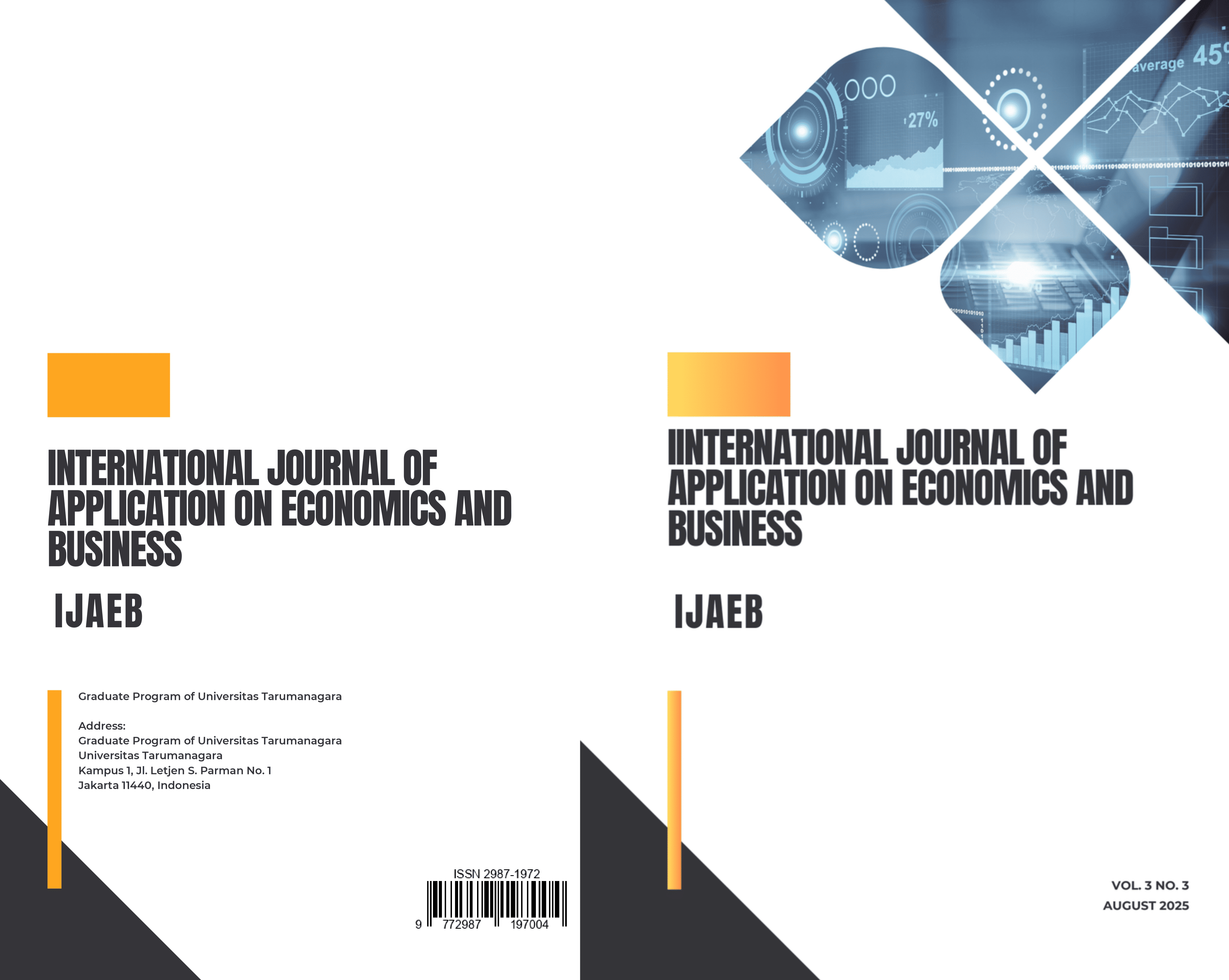COMPARATIVE ANALYSIS OF FINANCIAL PERFORMANCE OF PHARMACEUTICAL COMPANIES DURING AND AFTER THE COVID-19 PANDEMIC
Main Article Content
Abstract
The goal of this study is to evaluate the financial performance differences of pharmaceutical companies listed on the Indonesia Stock Exchange (IDX) during the COVID-19 pandemic (2020-2021) and after the pandemic (2022-2023). The research focuses on five main financial performance indicators: profitability, leverage, liquidity, efficiency, and company growth. Profitability is measured using Return on Assets (ROA) and Net Profit Margin (NPM), leverage through Debt to Equity Ratio (DER), liquidity through Current Ratio (CR), efficiency using Total Asset Turnover (TATO), and company growth through Sales Growth. The sample consists of 11 pharmaceutical companies listed on the IDX. Financial performance data before and after the pandemic will be analyzed using the paired sample t-test method to assess whether there is a significant difference between the two periods. This study aims to provide insights into the long-term effects of the COVID-19 pandemic on the financial performance of pharmaceutical companies in adapting to changes post-pandemic. The findings show no significant difference in ROA, NPM, CR, TATO, and Sales Growth between the pandemic period (2020-2021) and the post-pandemic period (2022-2023), though there is a difference in DER performance between the two periods.
Article Details

This work is licensed under a Creative Commons Attribution-NonCommercial-ShareAlike 4.0 International License.
This journal provides immediate open access to its content on the principle that making research freely available to the public supports a greater global exchange of knowledge.
IJAEB by Graduate Program of Universitas Tarumanagara is licensed under a Creative Commons Attribution-NonCommercial-ShareAlike 4.0 International License.. Permissions beyond the scope of this license may be available at https://journal.untar.ac.id/index.php/ijaeb
References
Agus Sartono. (2014). Manajemen Keuangan Teori dan Aplikasi (Edisi 4). BPFE Universitas Diponegoro.
Brigham, E. F., & Houston, J. F. (2014). Dasar-Dasar Manajemen Keuangan : Essetials Of Financial Management.
Brigham, Eugene F, & Daves, P. R. (2019). Intermediate Financial Management, 13th Edition (Vol. 21, Issue 3). Cengage Learning, Inc. https://doi.org/10.1016/0890-8389(89)90100-5
Daryanto, C., & Daryanto, W. M. (2019). Financial Performance Analysis and Evaluation of Pharmaceutical Companies in Indonesia. International Journal of Innovation, Creativity and Change, 6(3), 207–224.
Dewi, I. K., & Kencana, P. N. (2022). Dampak Pandemi Covid-19 Terhadap Kinerja Perusahaan Farmasi yang terdaftar di BEI. Jurnal Madani: Ilmu Pengetahuan, Teknologi, Dan Humaniora, 5(1), 54–67. https://doi.org/10.33753/madani.v5i1.197
Harahap, L. R., Anggraini, R., Ellys, E., & Effendy, R. Y. (2021). Analisis Rasio Keuangan Terhadap Kinerja Perusahaan PT Eastparc Hotel, Tbk (Masa Awal Pandemi Covid-19). Competitive Jurnal Akuntansi Dan Keuangan, 5(1), 57. https://doi.org/10.31000/competitive.v5i1.4050
Hidayat, M. (2021). Analisis Perbandingan Kinerja Keuangan dan Nilai Perusahaan Sebelum dan Disaat Pandemi Covid 19. Measurement Jurnal Akuntansi, 15(1), 9–17. https://doi.org/10.33373/mja.v15i1.3332
Hutapea, A. W., Saerang, I. S., Tulung, J. E., Manajemen, J., Sam, U., & Manado, R. (2017). Pengaruh Return on Asset Net Profit Margin, Debt To Equity Ratio dan Total Aset Turnover Terhadap Harga Saham Industri Otomotif Dan Komponen Yang Terdaftar di Bursa Efek Indonesia. Jurnal EMBA, 5(2), 541–551.
Jensen, M. C., & Meckling, W. H. (1976). Theory of the Firm: Mangerial Bahavior, Agency Cost and Ownership Structure. Journal of Financial Economics 3, 305–360. https://doi.org/10.1177/0018726718812602
Kasmir. (2019). Analisis Laporan Keuangan. PT. Raja Grafindo Nursada.
Kemenko Perekonomian Republik Indonesia. (2024). Dukung Transformasi di Sektor Kesehatan, Menko Airlangga Ajak Semua Pihak untuk Ciptakan Sistem Kesehatan yang Inklusif, Efisien, dan Berkelanjutan. Www.Ekon.Go.Id.
Liang, I., & Natsir, K. (2019). Pengaruh Profitabilitas, Likuiditas Dan Ukuran Perusahaan Terhadap Struktur Modal. Jurnal Manajerial Dan Kewirausahaan, I(9), 481–488.
Malik, S. W., Rizal, M., Rizaldy, M. A., Pratama, J., & Bello, F. (2023). Analisis Perbandingan Volume Penjualan Sebelum dan Sesudah Pandemi COVID-19 di PT. BAT Jakarta. Jurnal.JKP-BALI.COM.
Manalu, S. H., Murtanto, & Baradja, H. L. (2024). Analisis Perbandingan Kinerja Keuangan Perusahaan BUMN Industri Farmasi Sebelum Dan Sesudah Holding Periode 2018-2022. Student Research Journal, 2(1), 136–152. https://doi.org/10.55606/srjyappi.v2i1.1004
Miftahurrohman. (2021). Dampak Pandemi COVID-19 terhadap Kinerja Keuangan Perusahaan di Bursa Efek Indonesia. Jurnal Manajemen Sosial Ekonomi, 1(1), 1–13.
Nurazizah, I. (2021). Pengaruh Masa Pandemi Covid-19 Terhadap Penjualan di Apotek Populer Farma Kota Bekasi. Jurnal Sosial Sains, 1(10), 1326–1336. https://doi.org/10.59188/jurnalsosains.v1i10.213
Ross, S. a, Westerfield, & Jaffe. (2008). Corporate Finance, 9th Ed. McGraw-HIll Irwin.
Ruskar, D., Hastuti, S., Wahyudi, H., Widana, D. K. K., & Apriyadi, R. K. (2021). LAFIAL: Pandemi COVID-19 Sebagai Momentum Kemandirian Industri Farmasi Menuju Ketahanan Kesehatan Nasional. PENDIPA Journal of Science Education, 5(3), 528–545. https://doi.org/10.20473/jhi.v16i2.44486
Safitri, H., & Dr. Suwitho, M. S. (2015). Pengaruh Size, Growth, Dengan Kebijakan Dividen Sebagai Variabel Moderating Terhadap Nilai Perusahaan. Jurnal Ilmu Dan Riset Manajemen, 4(6), 1–15.
Sari, T. N., & Dura, J. (2022). Analisis Perbedaan Tingkat Profitabilitas Sebelum Dan Pasca Era New Normal. Studi Pada Sektor Farmasi di BEI. Jurnal Ilmiah Bisnis Dan Ekonomi Asia, 16(2), 260–272. https://doi.org/10.32812/jibeka.v16i2.837
Siallagan, H., & Machfoedz, M. (2006). Mekanisme Corporate Governance, Kualitas Laba dan Nilai Perusahaan.
Tarumingkeng, P. R. C. (2024). Strategi Pengembangan Organisasi. RUDYCT e-PRESS.
Taswan. (2003). Analisis Pengaruh Insider Ownership, Kebijakan Hutang Dan Dividen Terhadap Nilai Perusahaan Serta Faktor-Faktor Yang Mempengaruhinya. Jurnal Bisnis Dan Ekonomi, 10(2).
Tjandrawinata, R. R., & Liliasari, A. (2024). Phrma 4.0. Masa Depan Manufaktur Farmasi (Issue June). Atma Jaya Catholic University of Indonesia.



